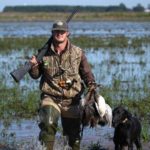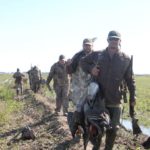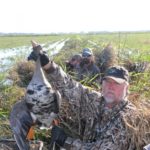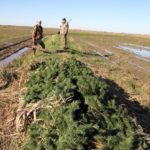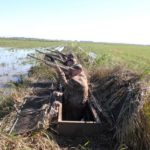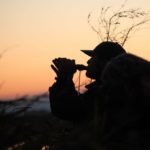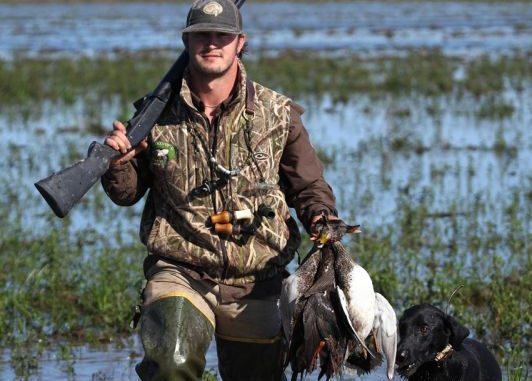
Geese are famous for being finicky. For staying just out of range, chuckling as hunters grind their teeth in frustration. But these guides know small adjustments can result in birds on the ground.
Shot-wise things were slow. Way too slow.
The speckle bellies were down in good numbers, but for some reason acting real finicky — just plain uppity at times.
First it appeared the birds wanted to work, but then seemingly they became uninterested and wouldn’t finish.
With only one white-fronted goose and several sunrise ducks to show for our efforts as the clock ticked past 8 a.m., our guide Benjamin Page called it.
“Hold up — hold up — don’t shoot,” Page called out in a loud voice, as he climbed out of the blind next to ours.
Both blinds were buried deep, end to end, along the rice field levee we hunted just east of Hayes below Highway 14.
There wasn’t any doubt we were where the birds wanted to be. After all, this part of the state is known for being the epicenter of the speckle-belly goose migration into Louisiana.
“Something’s wrong,” Page said, as he and a couple guys slogged out into the wet, mucky mud. “We’re pulling the Mojos and the snow goose decoys on the outside.”
Page and his partner Chip Martin of Martin Automotive Group in Lake Charles are co-owners of Barred Up Outfitters, which specialize in speckle-belly goose hunts.
The 28-year-old Page acts as head guide, for the most part. He and Martin are adept at getting their hunters on geese.
As the season progresses, white fronts become warier by the day. Knowing when something isn’t right, paying attention to little details and making the subtle changes that can turn a subpar day in the blind into a good hunt is what Page and Martin happen to excel at.
With the snow goose and Mojo decoys picked up, Page settled back into his pit blind.
It wasn’t long before our next opportunity came.
Page and one of his blind mates began calling, working a small group of specks. Unlike the birds that played games with us an hour earlier, these geese were looking to finish right over the top of the blind
The small adjustment worked, and guns went to blazing.
The rest of the morning, our group of Delta Waterfowl Lake Charles Gulf Coast Chapter and Louisiana/Mississippi regional directors had the specklebelly action most hunters hope for and expect when hunting Southwestern Louisiana.
The point is, whether you have the opportunity to hunt with a private land outfitter, lease a field or hunt public land, there are must dos and innovative techniques that can help you end your day with a heavy strap.
And Page and Martin shared their expertise to shorten the learning curve.
Concealment
Page said when birds aren’t responding it’s important to make sure there are no holes above the blind. Show him a guide who is a little bit OCD when it comes to blind concealment and he’ll show you a successful guide.
Our particular blinds incorporated flip-open tops. When closed, it would have taken a goose with a spotting scope and several low-altitude flybys to find anything out of place.
As a result, specks Page called in finished right over the top us.
Martin and Page had to adjust between the first and second splits last season because the farmer they lease from began working the rice-field levees, leaving them devoid of any grass whatsoever.
That meant their early season camouflage wouldn’t cut it any longer.
“People always ask, ‘Do birds see colors?’ and the answer is, probably not,” Page said. “But they do see shades. So, if something is out of line along that levee, to them that’s not natural. And, more than likely, it’s hunters.
“So matching camouflage is important. In other words matching what’s on the levee and incorporating it into the blind is a must.”
With nothing on the levee, Page planted rye grass. Afterwards he had to come up with something green that matched the grass to cover the blind.
What many goose hunters use in similar situations are cedar tree limbs. However, Page said it doesn’t take long for them to turn brown, and then you’re back to square one — not matching again.
So Page came up with the innovative idea of using artificial Christmas tree limbs. They are flexible, cover well, match the color of rye grass and would last through the entire season.
His idea actually worked. The holiday blind decorations fooled specklebellies much of the second split.
However, concealment isn’t all camouflage, according to the two outfitters.
Page mentioned how the farmer rolled and shaped the levee but avoided the area around the pit blinds themselves.
That meant some short, yellow grass remained around the pits.
Another problem that frequently occurs is hunters walking to and from blinds leave the ground muddy and full of boot prints, the outfitters said.
“When you get six to eight guys walking in there two, three or four times a week, it gets to be a little bit of a challenge,” Martin explained. “You also have to drive equipment to and from the levee. What we do is drive one single trail, stop at the blind and continue on all the way to the next levee.
“We don’t make circles or drive on top of the levee. We want the four-wheeler vehicle roads to look like the natural transition of a piece of farm machinery the birds see from the air.”
To cover up the yellow grass and boot tracks around the blind, Page actually rolled out the carpet: green outdoor turf carpet, to be exact.
Sound strange? Where the traditional waterfowl hunter might consider such an idea foolish, Page is willing to try things that appear unconventional.
Was it successful? Because it wasn’t quite natural, Martin said the jury is still out.
The ideal field setup
Having had the opportunity to hunt twice with Page and Martin last season, I was able to experience two conditions: wet and dry.
The early hunt happened to follow heavy rains that swept through the area. One side of the outfitter’s levee happened to hold water. The other side, though wet, didn’t have standing water.
As a result, we were able to shoot ducks as an added bonus.
However, white-fronted geese have adapted negatively over the years to the traditional combo duck/goose fields, Martin said.
“For specks, dry on one side with water on the other side is a no-no,” he explained. “A lot of guys in the past did that. They’d hunt ducks on one side and geese on the other. But now the birds have imprinted so much on that, so it’s a tip off for a goose.
“Ducks don’t seem to imprint as much as geese do. Now you pretty much have to have water on both sides or dry on both sides.”
Decoy placement is extremely important when setting up the ideal speck field.
Every goose guide worth his salt is aware of the effect wind direction has on decoy placement. They’re also aware of how far to set decoys away from the blind in order to get birds to fly over it.
Both factors are keys to successful hunts.
However, it’s also paying close attention to the little details, when things aren’t going well. Page pulling the Mojo and snow goose decoys became a game changer for us.
Page said minute changes can really turn a hunt around.
“On one particular hunt, I set my decoys out and I placed all but one of them facing away from the blind. It was a sentry,” he said. “It was looking back at the blind. Well, the birds weren’t working, so I went out and turned it facing away from the blind looking in the same direction as the others.
“The next three groups of birds came in perfect. In my way of thinking, when I have them all facing one direction, I don’t want any of them looking at the blind. But, honestly, there are other days I’ll set them out looking in all sorts of directions.”
The importance of calling
Page places a lot of emphasis on calling specklebellies.
In fact, he said the relative importance of camouflage, decoys and calling to in terms of killing white-fronts equates to 20 percent concealment, 20 percent decoy set up and 60 percent calling.
But callers have to be able to adjust. Page noted that what worked last year might not work as well this year.
Regardless of what the year brings, however, his initial approach remains the same with each flock passing near his blind.
“When I first see geese, I like to hit them with a two- or three-note call to see how they react,” Page said. “If they kind of rock a little bit, acting like they want to come my way, I’ll hit them with a few clucks and two notes, and read them again.
“Whatever they react to, I’m going to keep doing it.”
Burst-type calling is one of the biggest mistakes Page and Martin see hunters make. Page said this is when hunters blow calls more with their cheeks than with their diaphragm.
“Hunters need to learn how to run their call first,” Page said. “Some just get out there in the field and have a brand-new speck call and say, ‘Let me try it; it looks like fun.’
“I blew a lot of birds away learning, so what I’m saying is, it takes practice — a lot of practice.”
Martin pointed out how, over the years, calling has changed, and now clucks and murmurs are the norm.
“Geese in the air are communicating with each other and know specifically where they’re going,” Martin said. “So, honestly, you’re competing with birds talking to one another. But, once they respond to initial calling, where they appear to be committed, they’re in the final-approach category.
“That’s where you go to the clucks and murmurs. When they’re cupped and committed, dropping lower and lower, that’s when you shut up.”
Page also mentioned clucks should start out slow and low, and then increase in volume, rising to a sort of crescendo, before falling down scale again.
The technique takes some getting used to, but with practice it can be a game changer for even novice speck callers.
It was Page and Martin’s attention to detail that changed what started out to be a slow hunt into an above-average outing. We shot six more speckle-belly geese and a dozen ducks after the change, making for an outstanding rice field hunt.
One thing I learned hunting with these guys on our hunt, it’s all in the details if you want to be successful.
Editor’s note: Barred Up Outfitters can be reached at 337-802-2149.
